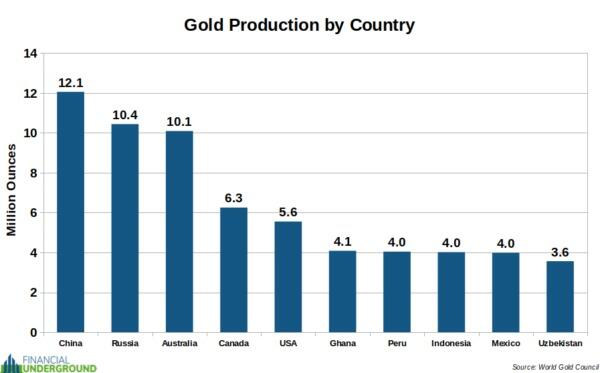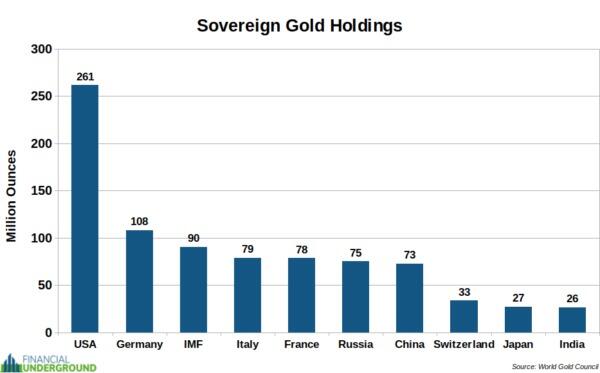The REPO Act: A Precursor To The Dollar's Downfall
Authored by Nick Giambruno via InternationalMan.com,
In the wake of Russia’s invasion of Ukraine in 2022, the US government has launched its most aggressive sanctions campaign ever.
The US government and its allies froze around $300 billion of the Russian central bank’s reserves—the nation’s accumulated savings.
It was a stunning illustration of the political risk associated with the US dollar and Treasuries. It showed that the US government could deny access to another sovereign country’s reserves at the flip of a switch.
Recently, President Joe Biden signed the REPO Act into law.
It allows the US government to seize frozen Russian state assets and transfer the funds to Ukraine.
The US dollar and Treasuries have become weaponized in a way they had not before. They are now clearly not neutral assets worthy of forming the bedrock of the international financial system but political tools for Washington to coerce others.
The rising political risk attached to Treasuries has made them even less attractive as a store of value. It’s now apparent to everyone that dollars are only dollars as long as you don’t upset the US government.
Many countries are undoubtedly wondering if the US government will seize their savings if they run afoul with Washington.
China is one of the largest holders of US Treasuries, and it indeed took note of what is happening.
Since 2022—when the US froze Russian state assets—China has sold about 25% of its Treasuries, an enormous change in such a short period.
In the first three months of 2024 alone, China dumped a record $53 billion worth of US Treasuries.
Further, China has increasingly ditched the US dollar in international trade. For example, over 90% of the $240 billion in trade between Russia and China is done outside of the dollar in yuan and ruble.
At the same time, China and Russia have been on a gold buying spree to make their economies and financial systems more resilient to US sanctions.
China is the world’s largest producer and buyer of gold. Russia is number two. Most of that gold enters the Russian and Chinese governments’ treasuries.
Russia has over 75 million ounces of gold, one of the largest stashes in the world. Nobody knows China’s exact amount of gold—Beijing is notoriously opaque—but most observers believe it is even larger than Russia’s stash.
Even if we take China’s official gold statistics—which almost certainly understate reality—Beijing’s gold holdings have soared by 17% in the past 17 months to around 73 million ounces.
China’s recent gold buying spree unsurprisingly coincides with the US seizure of Russian assets in the wake of the Ukraine conflict and their dumping of US Treasuries.
Conclusion
Treasuries have been the bedrock of the international financial system ever since President Nixon severed the dollar’s last link to gold in 1971.
However, the US government’s seizure of Russian state assets was a fundamental change to this system, signaling the end of an era.
The fiat US dollar can be either a neutral reserve asset or a political tool Washington wields. It cannot be both.
After 2022, Russia, China, and everyone else saw that the international financial system centered on the US dollar was over.
That is terrible news for the US dollar, which was already in big trouble as it is becoming clear the Fed is trapped in ever-increasing debasement.
Ray Dalio is one of the world’s most successful hedge fund managers. His success is due to his consistent ability to get the Big Picture right. He recently said this:
“The indicators of when a fiat currency is going to decline and to collapse, is when those holdings its debt sell the debt and the government, the central bank, has to print money to buy that debt in large size while the currency is going down. Those are the most important indicators.”
In short, I believe we are on the verge of a paradigm shift as gold replaces Treasuries as the base layer asset—the bedrock—of the international financial system.
The last time the international monetary system experienced a paradigm shift of this magnitude was in 1971.
Then, gold skyrocketed from $35 per ounce to $850 in 1980—a gain of over 2,300% or more than 24x.
I expect the percentage rise in the price of gold to be at least as significant as it was during the last paradigm shift.
That’s because this coming gold bull market could be fundamentally different from other cyclical bull markets. It will be riding the wave of a powerful trend: the re-monetization of gold as the king store-of-value asset. It could lead to the biggest gold bull market ever.
While this megatrend is already well underway, I believe the most significant gains are still ahead.
That’s precisely why I just released an urgent report on where this is all headed and what you can do about it… including three strategies everyone needs today. Click here to download the PDF now.
NEVER MISS THE NEWS THAT MATTERS MOST
ZEROHEDGE DIRECTLY TO YOUR INBOX
Receive a daily recap featuring a curated list of must-read stories.





